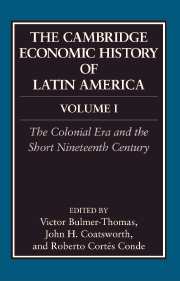Book contents
- Frontmatter
- Introduction
- Part I The Economic Background
- Part II Natural Resources and Factor Endowments
- Part III Economic Organization and Sectoral Performance
- 7 Political Economy and Economic Organization
- 8 Agriculture and Land Tenure
- 9 The Mining Industry
- 10 Premodern Manufacturing
- 11 Commercial Monopolies and External Trade
- 12 Money, Taxes, and Finance
- Part IV The Economic Impact of Independence
- Bibliographical Essays
- Index
- References
8 - Agriculture and Land Tenure
from Part III - Economic Organization and Sectoral Performance
Published online by Cambridge University Press: 28 March 2008
- Frontmatter
- Introduction
- Part I The Economic Background
- Part II Natural Resources and Factor Endowments
- Part III Economic Organization and Sectoral Performance
- 7 Political Economy and Economic Organization
- 8 Agriculture and Land Tenure
- 9 The Mining Industry
- 10 Premodern Manufacturing
- 11 Commercial Monopolies and External Trade
- 12 Money, Taxes, and Finance
- Part IV The Economic Impact of Independence
- Bibliographical Essays
- Index
- References
Summary
PRE-COLONIAL AGRARIAN SYSTEMS
According to José de Acosta’s model, put forward in his Historia naturaly moral de las Indias, first published in Seville in 1590, in the vast new world conquered by Spain “three kinds of government and life have been found among the Indians.” The Aztec empire in central Mexico and the Inca empire in Peru represented the most complex forms of government. They were established “republics,” in the Aristotelian sense, with hereditary royal houses and a high degree of agricultural development. For the other types of society, Father Acosta used the terms behetrías (independent towns or villages) or “totally barbarous.” The former included communities with their elected or at least less absolute rulers, which were smaller in terms of both population size and territorial extension, such as the Araucanians in the extreme south of the continent. The “barbarians” included “tribes,” such as the Chichimecas of northern Mexico, with economies based essentially on foraging. Acosta, like many other sixteenth-century Spaniards, also reflected on the relative ease of the conquest of the first type of indigenous society as compared to the difficulty of conquering the second and third type.
The greater political, economic, and agricultural development of the two large native empires, and the central position their territories had under the new colonial regime, justify making them the basic point of reference in our analysis of agrarian systems before and after the European conquest. The two periods are characterized by completely different socioeconomic structures. Nonetheless, between the time of the conquest and the completed formation of the colonial “mode” there occurred a century-long transition whose guiding principles were laid down during the long reign of Philip II (1527–98).
- Type
- Chapter
- Information
- The Cambridge Economic History of Latin America , pp. 275 - 314Publisher: Cambridge University PressPrint publication year: 2005
References
- 2
- Cited by

